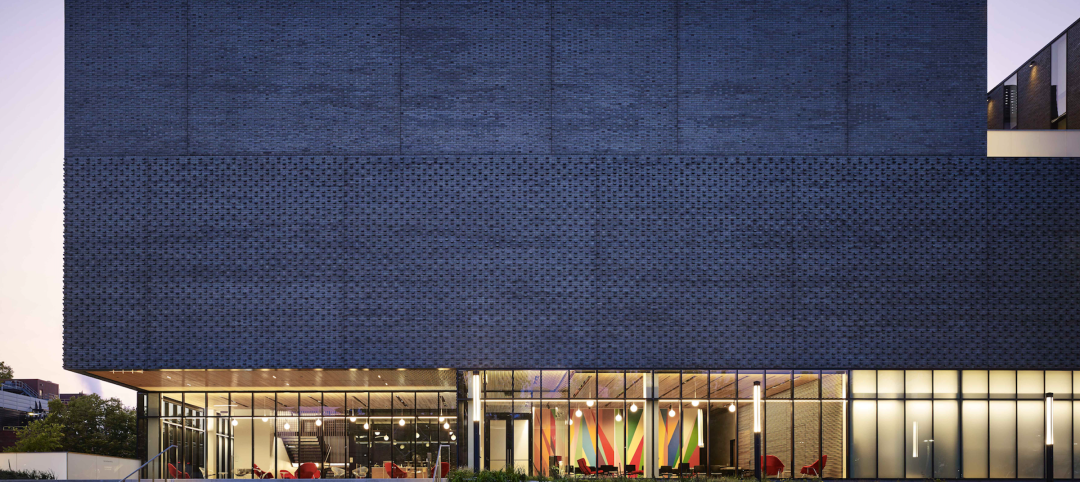Uncertainties about the country’s economic growth, energy prices, and labor wage inflation could have the greatest near-term impact on nonresidential construction spending, according to three leading economists.
Kermit Baker, PhD, of the American Institute of Architects, Alex Carrick of CMD (formerly Reed Construction Data), and Ken Simonson of the Associated General Contractors of America shared their prognostications in a webcast April 30. The next day, the Census Bureau released its estimates for the value of nonresidential construction put in place for March 2015—up 4.7% from the same month a year earlier, to an annualized $611.8 billion.
TOP CONTRACTOR GIANTS
2014 GC Revenue ($)
1. Turner Construction $10,797,472,734
2. Whiting-Turner $5,597,753,589
3. Jacobs $5,113,403,000
4. Skanska USA $4,952,400,044
5. PCL Construction $4,305,526,733
6. Balfour Beatty US $3,959,465,341
7. Gilbane Building Co. $3,632,871,000
8. Structure Tone $3,543,978,000
9. Clark Group $3,036,421,819
10. Lend Lease $2,682,278,000
TOP CM/PM GIANTS
2014 CM/PM Revenue ($)
1. Jacobs $1,621,620,000
2. AECOM $684,032,000
3. Hill International $405,000,000
4. Gilbane Building Co. $172,129,000
5. Turner Construction $151,664,266
6. JLL $150,158,676
7. Structure Tone $122,000,000
8. JE Dunn Construction $115,458,840
9. Flintco $105,300,000
10. WSP | Parsons Brinckerhoff $89,068,351
CONSTRUCTION GIANTS SPONSORED BY:
The trio painted a portrait of an economy that showed healthcare and education sectors, which account for two-thirds of institutional construction spending, still not fully recovered from the Great Recession. They projected lodging, amusement and leisure, and manufacturing to grow faster than construction spending as a whole.
The economists said they expect spending for nonresidential construction to rise in 2015 by somewhere in the 6.4–7.7% range. Construction spending should remain strong in 2016 before tailing off in the following two or three years.
Their expectations of industry projections were less optimistic than those of two construction giants. In its spring 2015 look at construction market conditions, Gilbane predicted nonresidential spending would be up 15.3% this year, even if starts were flat.
In its 2015 construction outlook, which it released in April, design-build and commercial real-estate development firm Leopardo pointed to several factors that could spark construction spending: low oil prices, which are keeping construction costs in check; a rise in public spending as a percentage of GDP, which in 2014 rose for the first time in years; and a downward slope in construction material costs, even for copper, which had risen nearly 73% from 2009 to 2014. Leopardo noted that nonresidential building markups have risen an average 6.6% a year since 2009, with school construction leading the pack.
Spending on education construction—which the Census Bureau estimated was off 3% in March—is one area where Carrick advised caution. He said he expects most of the demand for new construction to come from the lower grades.
Carrick said he was buoyed by economic strength in the high-tech knowledge sector; by the expansion of the Panama Canal, which is spurring development around U.S. tidewater ports; and by live/work mixed-use construction, which he said “is where the action is” on the nonresidential side. Carrick also called out energy extraction, notably shale oil, as a positive sign for the economy.
Simonson agreed that construction is benefiting from “the oil and gas revolution,” the Panama Canal expansion, and the recovery in the residential sector. But he said he’s watching three trends that could upset the apple cart: lower government spending on schools and infrastructure, online shopping’s impact on retail centers, and reductions in office space per employee, particularly in suburban markets.
EARLY WARNING SIGNS OF POTENTIAL THREATS
The economists sought clues from the first few months of 2015 about what track certain sectors might be on. CMD is enthusiastic about the growth in manufacturing construction spending, which Census estimated was up 50.3% YOY in March. Amusement and recreation, another potentially strong growth sector, was up 23.8% in March.
Carrick said he foresees “real growth” in the lodging sector, where spending was up 22% in March and where CMD projects 31% growth for all of 2015. CMD expects annual hotel occupancy rates to stay above 65% through 2017, compared to a 20-year average for 1994–2014 of 61.5%.
Baker’s spending projection—8% growth through 2016—is a bit more aggressive than Carrick’s or Simonson’s. One barometer he points to is the Architecture Billings Index, which is based on results from 750 leading firms. The ABI is “trending up,” he says, and 2015 could exceed 2008’s all-time high.
Baker’s optimism was tempered by an economy that, according to Commerce Department estimates, contracted by 0.7% in the first quarter, when monthly payroll gains were under 200,000. Baker said he also sees “wild cards” like energy prices and interest rates that could spike this year. The “biggest threat” to construction spending, he fears, could be the availability and cost of labor.
Between April 2006 and February 2015, construction employment shrank by 18%, to 6.3 million, with much of that loss on the residential side. A recent AGC poll found that 66% of its members were having trouble finding carpenters, and 43% couldn’t find project managers and supervisors.
The industry’s unemployment levels have been receding, from two million in March 2010, to 800,000 in March 2015. AGC estimates that 41 states and 249 metros added construction employment between March 2014 and March 2015.
So far, labor shortages haven’t translated into higher wages but Simonson said he expects that to change this year and next. Carrick said he’s keeping an eye on labor bottlenecks in other industries, such as last year’s work stoppages by longshoremen and truckers at West Coast ports, to gauge what might happen in construction.
RETURN TO THE GIANTS 300 LANDING PAGE
Related Stories
Giants 400 | Nov 6, 2023
Top 65 Cultural Facility Construction Firms for 2023
Turner Construction, Clark Group, Whiting-Turner, Gilbane, and Holder Construction top BD+C's ranking of the nation's largest cultural facilities sector general contractors and construction management (CM) firms for 2023, as reported in the 2023 Giants 400 Report. Note: This ranking includes revenue from all cultural building sectors, including concert venues, art galleries, museums, performing arts centers, and public libraries.
Giants 400 | Nov 6, 2023
Top 60 Cultural Facility Engineering Firms for 2023
KPFF, Arup, Thornton Tomasetti, Tetra Tech, and WSP head BD+C's ranking of the nation's largest cultural facilities sector engineering and engineering architecture (EA) firms for 2023, as reported in the 2023 Giants 400 Report. Note: This ranking includes revenue from all cultural building sectors, including concert venues, art galleries, museums, performing arts centers, and public libraries.
Giants 400 | Nov 6, 2023
Top 110 Cultural Facility Architecture Firms for 2023
Populous, Gensler, HGA, DLR Group, and Quinn Evans top BD+C's ranking of the nation's largest cultural facilities sector architecture and architecture engineering (AE) firms for 2023, as reported in the 2023 Giants 400 Report. Note: This ranking includes revenue from all cultural building sectors, including concert venues, art galleries, museums, performing arts centers, and public libraries.
Giants 400 | Nov 6, 2023
Top 100 Government Building Construction Firms for 2023
Hensel Phelps, Turner Construction, Clark Group, Fluor, and BL Harbert top BD+C's rankings of the nation's largest government building sector general contractors and construction management (CM) firms for 2023, as reported in the 2023 Giants 400 Report. Note: This ranking includes revenue from all government building sectors, including federal, state, local, military, and Veterans Affairs (VA) buildings.
Giants 400 | Nov 6, 2023
Top 90 Government Building Engineering Firms for 2023
Fluor, Jacobs, AECOM, WSP, and Burns & McDonnell head BD+C's rankings of the nation's largest government building sector engineering and engineering architecture (EA) firms for 2023, as reported in the 2023 Giants 400 Report. Note: This ranking includes revenue from all government building sectors, including federal, state, local, military, and Veterans Affairs (VA) buildings.
Giants 400 | Nov 6, 2023
Top 170 Government Building Architecture Firms for 2023
Page Southerland Page, Gensler, Stantec, HOK, and Skidmore, Owings & Merrill top BD+C's ranking of the nation's largest government building sector architecture and architecture engineering (AE) firms for 2023, as reported in the 2023 Giants 400 Report. Note: This ranking includes revenue from all government building sectors, including federal, state, local, military, and Veterans Affairs (VA) buildings.
Giants 400 | Oct 30, 2023
Top 170 K-12 School Architecture Firms for 2023
PBK Architects, Huckabee, DLR Group, VLK Architects, and Stantec top BD+C's ranking of the nation's largest K-12 school building architecture and architecture/engineering (AE) firms for 2023, as reported in Building Design+Construction's 2023 Giants 400 Report.
Giants 400 | Oct 30, 2023
Top 100 K-12 School Construction Firms for 2023
CORE Construction, Gilbane, Balfour Beatty, Skanska USA, and Adolfson & Peterson top BD+C's ranking of the nation's largest K-12 school building contractors and construction management (CM) firms for 2023, as reported in Building Design+Construction's 2023 Giants 400 Report.
Giants 400 | Oct 30, 2023
Top 80 K-12 School Engineering Firms for 2023
AECOM, CMTA, Jacobs, WSP, and IMEG head BD+C's ranking of the nation's largest K-12 school building engineering and engineering/architecture (EA) firms for 2023, as reported in Building Design+Construction's 2023 Giants 400 Report.
Giants 400 | Oct 23, 2023
Top 115 Multifamily Construction Firms for 2023
Clark Group, Suffolk Construction, Summit Contracting Group, Whiting-Turner Contracting, and McShane Companies top the ranking of the nation's largest multifamily housing sector contractors and construction management (CM) firms for 2023, as reported in Building Design+Construction's 2023 Giants 400 Report. Note: This ranking factors revenue for all multifamily buildings work, including apartments, condominiums, student housing facilities, and senior living facilities.


















